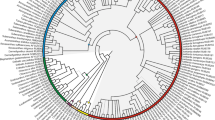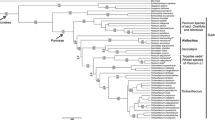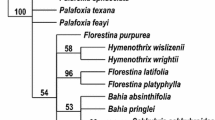Abstract
The genus Trigonella includes the widely cultivated T. foenum-graecum and a number of other medicinal and aromatic plant species distributed around the Mediterranean region. Sectional delimitation of Trigonella species is still based on morphology and interspecific relationships within the genus are not yet sufficiently resolved. Phylogenetic relationships in 22 species representing 11 of the 12 sections recognized within the genus Trigonella were analyzed using nuclear ITS and plastid trnL-F DNA sequences. Within nuclear ITS region, ITS-II was found to evolve faster compared to ITS-I. Maximal phylogenetic resolution and support was obtained in the combined analysis of the two selected regions. Trees resulting from maximum parsimony as well as Bayesian inference of combined data provided evidence for Trigonella being monophyletic with high support but did not agree with the traditional subgeneric division. Phylogenetic reconstructions indicated three major lineages supported by apomorphies in inflorescence and stipule. The phylogram supported the sectional delimitation of sections Cylindricae, Vérae, Samaroideae, Pectinatae, Erosae and Callicerates. There is strong support to combine monotypic sections Pectinatae and Erosae into one. However, species belonging to section Foenum-graecum and Falcatulae clustered in different subclades, contrary to their current classification. Inflorescence type appears to be a useful character with taxonomic potential for phenetic implications at subgeneric and sectional level within the genus. Moreover, some legume and seed characteristics, considered important in existing taxonomy, appear to have arisen more than once in Trigonella and are homoplastic.


Similar content being viewed by others
References
Acharya SN, Thomas JE, Prasad R, Basu SK (2010) Diseases of fenugreek (Trigonella foenum-graecum L.) and their control measures with special emphasis on fungal diseases. In: Arya A, Perello AE (eds) Management of fungal plant pathogens. CAB International, Wallingford, pp 245–261
Bena G (2001) Molecular phylogeny supports the morphological based taxonomic transfer of the “medicagoid” Trigonella species to the genus Medicago L. Plant Syst Evol 229:217–236
Bremer K (1994) Branch support and tree stability. Cladistics 10:295–304
Çeter T, Pinar M, Akan H, Ekici M, Aytaç Z (2012) Comparative seed morphology of Trigonella L. species (Leguminosae) in Turkey. Afr J Agric Res 7:509–522
Chase MW, De AY, Bruijn AV, Cox G, Reeves PJ, Rudall MAT, Johnson L, Eguiarte E (2000) Phylogenetics of Asphodelaceae Asparagales: an analysis of plastid rbcL and trnL-F DNA sequences. Ann Bot 86:935–951
Cunningham CW (1997a) Can three incongruence tests predict when data should be combined? Mol Biol Evol 14:733–740
Cunningham CW (1997b) Is congruence between data partitions a reliable predictor of phylogenetic accuracy? Empirically testing an iterative procedure for choosing among phylogenetic methods. Syst Biol 46:464–478
Dangi RS (2013) Diversity in genus Trigonella: molecular and chemical characterization. Ph.D. Dissertation, University of Pune, India
Dangi RS, Lagu MD, Choudhary LB, Ranjekar PK, Gupta VS (2004) Assessment of genetic diversity in Trigonella foenum-graecum and Trigonella caerulea using ISSR and RAPD markers. BMC Plant Biol 4:13
Ellison NW, Aaron A, Steiner JJ, Williams WM, Taylor NL (2006) Molecular phylogenetics of the clover genus (Trifolium—Leguminosae). Mol Phylogenet Evol 39:688–705
Endress PK, Doyle JA (2009) Reconstructing the ancestral flower and its initial specializations. Am J Bot 96:22–66
Farris JS (1989) The retention index and homoplasy excess. Syst Zool 38:406–407
Farris JS, Kallersjo M, Kluge AG, Bult CJ (1994) Testing significance of incongruence. Cladistics 10:315–319
Farris JS, Kallersjo M, Kluge AG, Bult CJ (1995) Constructing a significance test for incongruence. Syst Biol 44:570–572
Fazli FRY (1967) Studies in steroid-yielding plants of the genus Trigonella. Dissertation, University of Nottingham, England
Felsenstein J (1985) Confidence limits on phylogenies: an approach using the bootstrap. Evolution 39:783–791
Feng CM, Xiang QA, Franks RG (2011) Phylogeny-based developmental analyses illuminate evolution of inflorescence architectures in dogwoods (Cornus s. l., Cornaceae). New Phytol 91:850–869
Gazara M, Kamel W, Haider A (2001) Cladistic analysis of the genera: Trifolium, Trigonella and Melilotus (Fabaceae: Papilionaceae) in Egypt. Egypt J Biol 3:161–170
Gielly L, Taberlet P (1994) The use of chloroplast DNA to resolve phylogenies: non-coding versus rbcL sequences. Mol Biol Evol 11:769–777
Greuter W, Raus T (eds) (1987) Med-Checklist Notulae, 14. Willdenowia 16:439–452
Harris EM (1999) Capitula in the Asteridae: a widespread and varied phenomenon. Bot Rev 65:348–369
Hector JN (1938) Introduction to the botany of field crops (non cereals). Central News Agency Ltd, Johannesburg, p 1127
Heyn CC (1981) Trifolieae. In: Polhill RM, Raven PH (eds) Advances in legume systematics, Part 1. Royal Botanic Gardens, Kew, pp 383–385
Hillis DM (1995) Approaches for assessing phylogenetic accuracy. Syst Biol 44:3–16
Howie J, Ballard RA, de Koning C, Sandral G, Charman N (2001) Trigonella balansae—a new pasture legume for the alkaline soils of Southern Australia? In: Proceedings of the 10th Australian agronomy conference, Hobart. Australian Society of Agronomy. http://www.regional.org.au/au/asa/2001/3/d/howie.htm. Accessed 20 Nov 2013
Huber-Morath A (1970) Trigonella L. In: Davis PH (ed) Flora of Turkey and the East Aegean Islands, vol 3. Edinburgh Univ. Press, Edinburgh, pp 452–482
Huelsenbeck JP, Larget B, Miller RE, Ronquist F (2002) Potential applications and pitfalls of Bayesian inference of phylogeny. Syst Biol 51:673–688
Hutchinson J (1964) The genera of flowering plants. Clarendon Press, Oxford, pp 947–952
Ingham JL (1981) Phytoalexin induction and its chemosystematic significance. Biochem Syst Ecol 9:275–281
Kakani RK, Singh SK, Pancholy A, Meena RS, Pathak R, Raturi A (2011) Assessment of genetic diversity in Trigonella foenum-graecum based on nuclear ribosomal DNA, internal transcribed spacer and RAPD analysis. Plant Mol Biol Rep 29:315–323
Kluge AG, Farris JS (1969) Quantitative phyletics and the evolution of anurans. Syst Zool 8:1–32
Kores PJ, Molvray M, Weston PH, Hopper SD, Brown AP, Cameron KM, Chase MW (2001) A phylogenetic analysis of Diurideae (Orchidaceae) based on plastid DNA sequence data. Am J Bot 88:1903–1914
Ladizinsky G (1979) Seed protein electrophoresis in the section Foenum-graecum of Trigonella L. (Fabaceae). Plant Syst Evol 133:87–94
Lashin GMA (2006) Comparative morphology of pollen grains of some taxa of tribe Trifolieae (Fabaceae: Papilionoideae) from Egypt. Int J Bot 2:270–277
Lavin M, Doyle JJ, Palmer JD (1990) Evolutionary significance of the loss of the chloroplast-DNA inverted repeat in the Leguminosae subfamily Papilionoideae. Evolution 44:390–402
Liston A (1995) Use of the polymerase chain reaction to survey for the loss of the inverted repeat in the legume chloroplast genome. In: Crisp MD, Doyle JJ (eds) Advances in legume systematic, part 7: phylogeny. Royal Botanic Gardens, Kew, pp 31–40
Liston A, Wheeler JA (1994) The phylogenetic position of the genus Astragalus (Fabaceae): evidence from the chloroplast genes rpoC1 and rpoC2. Biochem Syst Ecol 22:377–388
Liston A, Sterner J, Taylor NL, Ellison NW, Williams WM (2001) Phylogeny of New World Trifolium. Identification of a cryptic clade (abstract). 4th International legume conference
Liu FR, Miyamoto MM (1999) Phylogenetic assessment of molecular and morphological data for Eutherian mammals. Syst Biol 48:54–64
Marcilla A, Bargues MD, Ramsey JM, Magallon-Gastelum E, Salazar-Schettino P, Abad-Franch F et al (2001) The ITS-II of the nuclear rDNA as a molecular marker for populations, species, and phylogenetic relationships in Triatominae (Hemiptera: Reduviidae), vectors of Chagas disease. Mol Phylogenet Evol 18:136–142
Nair RM, Dundas IS, Wallwork M, Verlin DC, Waterhouse L, Dowling K (2004) Breeding system in a population of Trigonella balansae (Leguminosae). Ann Bot 94:883–888
Niknam V, Sharifizadeh B, Ebrahimzadeh H, Zarre S (2004) Comparative study of proteins in seeds of some species of Trigonella from Iran. Iran Int J Sci 5:1–11
Nixon KC, Carpenter JM (1996) On simultaneous analysis. Cladistics 12:221–241
Parkin J (1914) The evolution of the inflorescence. Bot J Linn Soc 42:511–563
Petropoulos GA (2002) Fenugreek the genus Trigonella. Taylor and Francis, London and New York, pp 1–255
Posoda D, Crandall KA (1998) Modeltest, testing the model of DNA substitution. Bioinfomatics 14:817–818
Rechinger KH (1984) Trigonella. In: Rechinger KH (ed) Flora Iranica, vol 157. Akad. Druck- Verlagsanstalt, Graz, pp 207–253
Rogers SO, Bendich AJ (1985) Extraction of DNA from milligram amounts of fresh, herbarium and mummified plant tissues. Plant Mol Biol 5:69–76
Ronquist F, Huelsenbeck JP (2003) MrBayes 3: Bayesian phylogenetic inference under mixed models. Bioinformatics 19:1572–1574
Rouk HF, Mangesha H (1963) Fenugreek (Trigonella foenum-graecum L.) its relationship, geography and economic importance, Exper Stat Bull No. 20, Imper. Ethiopian College of Agric. & Mech. Arts
Sambrook J, Russell DW (2001) Molecular cloning: a laboratory manual. Cold Spring Harbor Laboratory Press, New York
Sanderson MJ, Wojciechowski MF (1996) Diversification rates in a temperate legume clade: are there “so many species” of Astragalus (Fabaceae)? Am J Bot 83:1488–1502
Schultz OF (1901) Monographie der Gattung Melilotus. Botanische Jahrbücher für Systematik, Pflanzengeschichte und Pflanzengeographie 29:660–735
Seelanan T, Schnabel A, Wendel JF (1997) Congruence and consensus in the cotton tribe (Malvaceae). Syst Biol 22:259–290
Sinskaya E (1961) Flora of the cultivated plants of the USSR: XIII perennial leguminous plants. Part I: Medicago, Sweet clover, Fenugreek. Israel Programme for Scientific Translations, Jerusalem, pp 514–570
Širjaev (1928–1932) Generis Trigonella L. revisio critica Vol 1. Volume 102 of Spisy vydávané Přirodovědecká Fakultou Masarykovy University Přirodověd. Fak., Brno
Small E (1987a) A taxonomic study of the “medicagoid” Trigonella (Leguminosae). Can J Bot 65:1199–1211
Small E (1987b) Polythetic generic separation in the tribe Trifolieae subtribe Trigonellinae (Leguminosae). Can J Bot 67:1480–1492
Small E, Jomphe M (1989) A synopsis of the genus Medicago (Leguminosae). Can J Bot 67:3260–3294
Sorenson MD (1999) TreeRot, version 2. Boston University, Boston
Stebbins GL (1974) Flowering plants: evolution above the species level. Belknap Press, Cambridge
Steele KP, Wojciechowski MF (2003) Phylogenetic analyses of tribes Trifolieae and Vicieae, based on sequences of the plastid gene matK (Papilionoideae: Leguminosae). In: Klitgaard BB, Bruneau A (eds) Advances in legume systematics, part 10, higher level systematics. Royal Botanic Garden, Kew, pp 355–370
Steele KP, Ickert-Bond SM, Zarre S, Wojciechowski MF (2010) Phylogeny and character evolution in Medicago (Leguminosae): evidence from analyses of plastid trnK/matK and nuclear GA3ox1 sequences. Am J Bot 97:1142–1155
Swofford DL (2001) PAUP*: phylogenetic analysis using parsimony (*and other methods), version 4. Sinauer, Sunderland
Taberlet P, Gielly L, Pautou G, Bouvet J (1991) Universal primers for amplification of three non-coding regions of chloroplast DNA. Plant Mol Biol 17:1105–1109
Thompson JD, Higgins DG, Gibson TJ (1994) CLUSTAL W: improving the sensitivity of progressive multiple sequence alignment through sequence weighting, position specific gap penalties and weight matrix choice. Nucl Acids Res 22:4673–4680
Tutin TG, Heywood VH, Burges NA, Moore DM, Valentine DH, Walters SM, Webb DA (1969) Flora Europaea. Vol. 2. Rosaceae to Umbelliferae. Cambridge University Press, Cambridge
Vasil’chenko IT (1953) (Bericht über die Arten der Gattung Trigonella) Trudy Bot. Inst. Akad. Nauk. I 10:124–269 (In Russian)
Watson LE, Sayed-Ahmed H, Badr A (2000) Molecular phylogeny of Old World Trifolium (Fabaceae). Plant Syst Evol 224:153–171
White TJ, Bruns T, Lee S, Taylor J (1990) Amplification and direct sequencing of fungal ribosomal RNA genes for phylogenetics. In: Innis MA, Gelfand DH, Sninsky JJ, White TJ (eds) PCR protocols: a guide to methods and applications. Academic Press, London, pp 315–322
Wojciechowski MF (2003) Reconstructing the phylogeny of legumes (Leguminosae): an early 21st century perspective. In: Klitgaard BB, Bruneau A (eds) Advances in legume systematic, part 10, higher level systematics. Royal Botanic Garden, Kew, pp 5–35
Wojciechowski MF, Sanderson MJ, Steele KP, Liston A (2000) Molecular phylogeny of the “Temperate Herbaceous Tribes” of Papilionoid legumes: a supertree approach. In: Herendeen PS, Bruneau A (eds) Advances in legume systematics, vol 9. Royal Botanic Gardens, Kew, pp 277–298
Wojciechowski MF, Lavin M, Sanderson MJ (2004) A phylogeny of legumes (Leguminosae) based on analysis of the plastid matK gene resolves many well-supported subclades within the family. Am J Bot 91:1846–1862
Acknowledgments
The authors wish to thank Dr. Steve Hughes, Curator, The Genetic Resource Centre, South Australian Research and Development Institute (SARDI), Waite Research Precinct, Waite Institute, Urrbrae, South Australia for the supply of germplasm used in this study.
Conflict of interest
The authors declare that they have no conflict of interest.
Author information
Authors and Affiliations
Corresponding author
Electronic supplementary material
Below is the link to the electronic supplementary material.
Rights and permissions
About this article
Cite this article
Dangi, R., Tamhankar, S., Choudhary, R.K. et al. Molecular phylogenetics and systematics of Trigonella L. (Fabaceae) based on nuclear ribosomal ITS and chloroplast trnL intron sequences. Genet Resour Crop Evol 63, 79–96 (2016). https://doi.org/10.1007/s10722-015-0236-4
Received:
Accepted:
Published:
Issue Date:
DOI: https://doi.org/10.1007/s10722-015-0236-4




